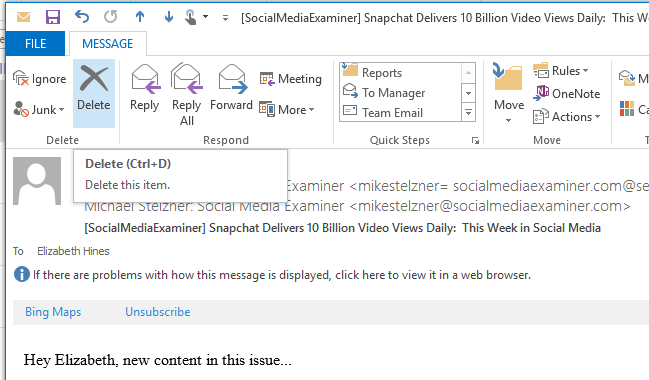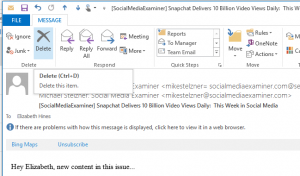
by Fronetics | May 3, 2016 | Blog, Content Marketing, Marketing, Strategy

These tips will help you optimize your marketing emails to improve open rates.
Are you spending time creating marketing emails that nobody opens?
Today, everyone’s inbox is inundated with social media notifications, contests and giveaways, and marketing emails from every company they have even considered buying from in the last five years. How do you make your message stand out enough to not get deleted — let alone, read?
First and foremost, you must look at first-impression factors like subject lines, overall design, organization and formatting, and even when you are sending your emails.
For example, you may imagine potential customers sitting at their desks first thing each morning and going through emails, but that is not necessarily the case. Email marketing company Constant Contact finds that optimal open times vary widely by industry. But, truth be told, the best time for your business to send emails will be unique to your business — and the best way to know when is to test.
Another important factor to consider is how your potential customers are reading email. A recent Experian study found that 56% of email opens occur on a mobile device. If you send a marketing email that is not optimized for mobile, more than half of your recipients are straining and struggling to read your content. You’ve given them a good reason to delete it instead of reading it.
With these things in mind, how do you create marketing emails that potential customers will actually open and read? Here are a few basics:
Optimize what the recipient first sees.
Your sender name should be easily identifiable as coming from you, as this will influence if your reader opens your message.
Convey your point in the subject line.
Your subject line is the first thing your readers see and a major determinant in whether the recipient will open your email or hit delete. It should be short (under 70 characters so it does not get cut off), catchy, and attention-grabbing, but also to-the-point. Recipients should understand what the email is about without even opening it, but the subject line should hook them into wanting to know more.
Create a sense of urgency.
Give customers a reason to act quickly, rather than let the email sit in their inbox. Craft this sense of urgency within your subject line with some form of time limit or “what-you-must-know-now” phrasing.
Avoid words that label your email as spam.
Always avoid using words like “Cash,” “Quote,” and “Save.” Filters are designed to move emails with these words into spam.
Make it personal.
If the recipient is someone with whom you have done business or a potential customer that has signed up for newsletters or promotions, make it personal. Including their name makes the email feel conversational and almost rude if they don’t open it and at least see what you have to say to them. Studies show that personalized email subject lines increase open rates across industries by as much as 40%.
Certainly, open rates are not the only measure of success when it comes to marketing emails. But, to achieve your goals, it is vital to optimize the number of people who actually read your marketing message. Simply put, you cannot reach your audience unless you garner their interest quickly and get them to open up your message.
Related posts:

by Fronetics | May 2, 2016 | Blog, Content Marketing, Marketing, Social Media, Strategy, Supply Chain

Image credit: startbloggingonline.com
Here are three of the top benefits of social media for businesses in the supply chain and logistics industries.
We know that the majority of businesses participate in social media — in fact, a dominant 88% of B2B marketers report using these platforms as part of their marketing programs. Large corporations, small businesses, and those in between are promoting their brand and engaging with customers online. Even companies within the logistics and supply chain industries are joining the bandwagon and reaping the benefits of social media marketing.
The truth is, if your company is not participating in social media, you are at a disadvantage. Your customers, your employees, and your competitors are taking advantage of these technologies to conduct business in new, more efficient ways.
Why are so many companies using these tools?
Here are just three of the top benefits of social media for business:
1) Communicate and engage
By participating in social media, your business has at its fingertips a highly efficient, sophisticated platform for engaging customers, employees, potential hires, industry peers, and the general public. You can announce a new product launch; share small or sweeping changes in service, supplies, practices, locations, etc.; respond to questions or complaints; weigh in on industry discussions happening on online forums; and celebrate employee milestones and accomplishments.
2) Generate and nurture leads
Social prospecting is the process of using social technologies to identify and pursue potential customers that may be interested in your company but that don’t yet know about it. Your business can prospect from the 2.3 billion worldwide social media users, engage them with relevant content, and form and build relationships that you otherwise would have never encountered were it not for the World Wide Web.
3) Reduce marketing expenses
It’s free to set up social media accounts for your business. The real cost comes with dedicating resources to maintain and monitor the content on each channel, and those needs will vary from business to business. Even if you do chose to upgrade and pay for premium benefits and services, like ads, the cost is significantly lower than using many traditional mediums. One recent study suggests that the cost per thousand impressions (CPM) could be as low as $2.50, while traditional tactics, like direct mail ($57 CPM) and TV ads ($28 CPM), remain significantly higher.
Learn more about social media for business in Fronetics’ new white paper, Social Media and the Logistics and Supply Chain Industries. The paper defines social media and social technologies, identifies users and usage patterns, and describes more benefits companies within the logistics and supply chain industries can realize through participation.

Related posts:

by Fronetics | Apr 28, 2016 | Blog, Marketing, Social Media, Strategy

In today’s digital world, it is amazing that many businesses, particularly those in the supply chain and logistic industries, are still questioning whether they should be on social media. The simple answer is yes — social media channels are the ideal place to brand, market, and grow your business.
Here are five reasons why your company should be on social media.
1. Lead generation.
Sales teams can also use social media as a lead-generation tool. Social media takes the old marketing billboard and makes it a conversation, which is a huge benefit to businesses who use it well.
2. Trust and thought leadership.
Though the results are not instant, the amount of time and marketing dollars you spend on social media pays off. How long will it take? That varies depending on your business and your sales cycle. But by distributing quality content and engaging customers through these channels, you eventually will establish your company as a knowledgeable, thought-leader in your industry. This creates a level of trust with potential customers, which is invaluable to securing the sale down the road.
3. Brand awareness.
Social media not only builds your brand but can expand your content’s reach. Those who follow you and enjoy your content will “like” and share it, meaning their followers will see it, thus expanding your audience. This makes your reach virtually limitless, providing that your content is compelling, engaging, and worthy of sharing.
4. Business intelligence.
Being on social media keeps you on top of the latest trends; it is a valuable business tool. You not only engage potential customers, but you can learn what they are looking for, what your competition is doing. It can also provide data that serves as a strategic compass to generate ideas and guide the direction of your business in the future.
5. Talent acquisition.
You can find new talent for your company through social media, which gets you connected with qualified job-seekers and streamlines the search process.
Harvard Business Review surveyed 2,100 companies and found that 79% use or plan to use social media. But, only 12% of those organizations felt that they were using social media effectively. The fact is unless you are using social media correctly, you will probably not see the results that you desire.
Content needs to be fresh, engaging, informative and sometimes entertaining. You need to post consistently and respond to questions that are posted by your readers. (You are creating a relationship, after all.) All of this may seem daunting, but the reward is a highly visible, respected, presence within the social media community. Your business can strategically reach a myriad of potential customers online, which as you know, can be a game-changer in its potential for growth.
Related posts:

by Fronetics | Apr 27, 2016 | Blog, Content Marketing, Marketing, Social Media, Strategy

Fronetics’ social media training offers basic instructions on how you can help your company get invited, show up, and make a good impression with customers online.
What if you were told that a number of potential customers all visit the same place to chat and get to know businesses like yours before they choose to buy from them? Would you feel there was a strong reason for your business to have a presence there?
The answer is definitively, “Yes, absolutely!” Yet, some businesses are not establishing a social media presence — today’s ultimate social meeting establishment — which puts them in position of severe disadvantage.
Though you may be hesitant to participate, the various social media platforms are the place to meet, greet, and establish trusting relationships with your potential customers before they commit to a purchase. So, either show up, grab a drink, and chat, or surrender opportunities to your competition, who, by the way, is already “liked” by the masses.
How to Make an Entrance at the Social Media Party
Feeling a bit lost as to how to navigate social media? Don’t simply resign yourself to being the wallflower at this gathering. Make an entrance and get noticed!
Fronetics Strategic Advisors has created a social media training, specifically designed for business owners (B2B and B2C), marketers, and employees who are seeking a better grasp on social technologies. Consider it Social Media for Businesses 101: The training offers step-by-step instructions on using your individual social media presence to help boost your company’s social footprint.
No need to be shy. You know more, and can have a bigger impact, than you think. To be sure, the B2B sales process has evolved, but the basics remain: create conversation; educate the consumer; establish trust; and, eventually, generate a sales lead. But now you and your business can conduct this courting via digital platforms.
In this training, learn how social media is an opportunity for building brand awareness and allowing potential customers to get to know your business. See how you can make an impact on your company’s growth through Facebook, Twitter, and LinkedIn. And get a grasp on the fundamentals — as basic as how to “like” or “follow” your company — so that you feel more comfortable using social media in a professional context.
Social media is limitless opportunity for engagement and branding for your company. Participating across multiple platforms is an ideal way to expand brand awareness and establish your company as a thought leader in its industry. Don’t miss out on the party! Download Fronetics’ Social Media Training below so you can participate in the conversation happening online.
Get the free training
Related posts:
Fronetics Strategic Advisors welcomes your questions about social media, and can advise you on how to best leverage it to your company’s greatest advantage. Contact us for a free social media assessment.

by Fronetics | Apr 26, 2016 | Blog, Strategy
 Engage your leads early in meaningful dialogue to improve your chances of conversion.
Engage your leads early in meaningful dialogue to improve your chances of conversion.
Your strategic marketing plan is generating a steady influx of quality leads, so closing sales should be easy, right? Only if you are contacting your leads early enough in the sales cycle.
Leads become sale opportunities if they are approached like a garden. Care is needed from the start to cultivate and produce the desired results. So, when is the perfect time to begin nurturing leads? It is earlier than you might think.
When a potential customer first shows interest in a blog post, opens an email, or shares your company’s post on social media, this is the first point of positive contact. You needs to keep that contact going and develop it into a conversation. And we are not talking about starting out with a sales pitch, either. Leads become sales when they are cultivated and grown like a trusted relationship — and the earlier after first contact the better.
According to a study published in the Harvard Business Review, most companies are not responding nearly fast enough to their sales leads. The authors audited more than 2,200 businesses and measured their response time to web-generated leads. While only about a third (37%) responded within an hour, the average first response time was 42 hours. Surprisingly, 23% of companies never responded.
Google and Corporate Executive Board’s white paper on lead follow-up offers some insight on why quick responses are so important. For one, a reported 35% to 50% of sales go to the vendor that responds first. That is largely because today’s B2B customers are nearly 60% through the sales process before they first engage a sales rep. By the time you hear from them, they are close to buying and want answers in a timely fashion to make their decision.
So, how fast of a response is ideal? A study conducted by Franklin Covey found that contact ratios improve 900% if web leads had some form of contact by the company within five minutes of submission. Now, it is probably not possible for your sales team to act upon every lead with that kind of velocity, but it is vital that they utilize proactive sales strategies, rather than reactive.
Reactive is leaving a message and, if they hear back, responding to it. Proactive is going after the sale with confidence and commitment to engaging the lead in real dialogue.
Early dialogue: What it is, and what it’s not
Early on in the sales cycle, you are not pushing to close the sale, but rather you are building a relationship through conversations. You are creating dialogue, not a sales monologue. Be there first, be relevant, and be action-oriented, and your customers will rely on your solutions more often.
You begin this dialogue by asking great, open-ended questions, essentially taking the time to get to know the potential customer. This helps you determine what will best suit this prospect’s needs, and it builds confidence and trust and will very often help the prospect consider issues they may never have thought of.
When you get that potential customer thinking outside the boundaries of their initial issue, it provides a bigger opportunity for you to showcase how your services or products can solve several of the customer’s dilemmas. It is also important to consider your products or services in terms of how they benefit the customer; your presentation will then be customer-focused, and that builds trust and respect in the relationship.
There many moving parts to an effective lead-nurturing campaign, and often there are many steps required to cultivate those leads into sales. From the start of the sales cycle, your company should:
- Take the time to discover and understand the potential customer’s needs and wants first, then advise and offer information. Make the move to match and sell the appropriate solution your company can offer.
- Have the ability to listen and offer viable solutions. Your sales team needs to be well informed about the products, services, and solutions that they are selling.
- Your sales team must be able to follow up quickly, consistently, and with an open dialogue to turn leads into customers.
Studies show that the faster you begin dialogue with a lead, the better your chances of conversion into a sale. This means that when cultivating a qualified lead, you don’t want your sales reps to make one phone call and simply leave a voicemail. You want real conversations to happen. If you don’t, your lead-generation efforts were for naught.
Related posts:

by Fronetics | Apr 25, 2016 | Blog, Strategy, Supply Chain

Image source: tomicpasko | Flickr
They are your employees. They are your customers. Pretty soon, Millennials will be the supply chain.
As Millennials now outnumber Generation X and Baby Boomers in the workforce, shifts in ideas and processes were inevitable. But this generation is having an even more palpable impact: They are reshaping the economy as we know it, forcing businesses to reexamine traditional methods of buying and selling to accommodate their unique preferences and experiences.
A 2014 survey found that 46% of B2B buyers were Millennials, and that number is on the rise. Their preferences and behaviors are having a noticeable impact on B2B buyer behavior as a whole. In short, the supply chain should be prepared to change the way business is conducted to account for this generation’s impact.
Who are Millennials?
The term “Millennials” describes the generation of Americans born between 1982 and 2000. The more than 83 million Millennials represent a quarter of the US population, and are more diverse than any previous generation, with 44.2% being a part of a minority race or ethnic group.
Millennials are generally highly educated, though often underemployed and saddled with debt. They are digital natives who are decidedly collaborative by nature. Having grown up in a time of rapid technological advancement, their expectations and priorities are much different than previous generations. They’re delaying marriage and parenthood in favor of higher education and travel, fueling their strong sense of optimism. And they generally are reluctant to make major purchases — like homes, cars, and even music — instead favoring services that provide access to products without ownership, fueling the growth of the collaborative economy.
Ads be gone
Bombarded with over 5,000 marketing messages a day, every day for their entire lives, Millennials are able tune out traditional advertisements. They are turned off by direct sales pitches and much prefer word-of-mouth recommendations or joining communities around brands they like to learn about products and services. They are easily incentivized and want to be rewarded for their brand loyalty with things like discounts, access to information, and personalized communications.
Reshaping retail
Millennials are highly attached to technology. More than half go online multiple times per day, while more than a third (36%) report going online “almost constantly.” Approximately 90% are active on at least one social media network. They expect brands and businesses to have a digital presence and engage with them online — especially if they have a complaint or problem.
Having the internet at their fingertips shapes how Millennials shop. Their constant access to product information, user reviews, and price comparisons allows them to favor brands and products that offer maximum convenience at the lowest cost. Catering to their proclivity for the best for the least, giant retailers like Amazon have reset expectations for shipping times, availability, and price.
Millennials have taken shopping mobile. Around 92% will use a mobile device while they shop, and 78% will use an app to shop. And the revolution is far from over : Artificial intelligence, robots, and drones represent a new wave of technology that many tech companies, driven by Millennial innovators, are just a short step from achieving.
Related posts:








